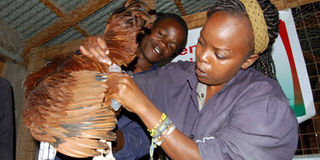Tired of artificial insemination? Try embryo transfer

Researcher Sophie MIyumo carrying out an artificial insemination procedure on a chicken at Egerton University, Njoro in Nakuru County on March 28, 2014. PHOTO | SULEIMAN MBATIAH
What you need to know:
- This involves retrieval of embryos from a genetically superior cow and placing them in surrogate cows, where they develop into a foetus.
- Surrogate cows need to be reproductively sound in terms of having normal estrus cycles, exhibit calving ease and have good milking ability to ensure successful embryo transfer.
Increased demand for better breeds has led to development of centres, which involve nucleus herds, where intense selection to produce elite animals is done.
The resulting genetic improvement is then disseminated to farmers in two ways, either by offering bulls for natural mating or reproductive technologies such as artificial insemination and embryo transfer.
In the past, the norm involved importation of breeding stock primarily young bulls with outstanding pedigrees for use in the nucleus herd and consequently disseminating their offspring to dairy farmers for herd improvement.
However, this method proved to be costly due to high transportation costs, morbidity and mortality arising from environmental conditions.
Breeding centres are now relying mostly on reproductive technologies. Artificial insemination, the most-widely used technology in the dairy industry exploits genetically superior males. This has been done for ages. But now, breeding centres are also embracing embryo transfer.
This involves retrieval of embryos from a genetically superior cow and placing them in surrogate cows, where they develop into a foetus.
In embryo transfer, the offspring has 100 per cent of the desired genes since it exploits superior genes of males and females.
Embryo transfer technology in cattle was developed to increase the reproductive rates of genetically valuable females, mainly because of low reproductive rates and long generation intervals. This has proved useful.
The reproductive potential of each normal new-born calf, whether male or female, is enormous. There are an estimated 150,000 potential “eggs” or ova in the female and countless billions of sperm produced by each male.
Through natural breeding, only a fraction of the reproductive potential of an outstanding animal can be realised. The average bull will sire 15 to 50 calves a year and the average cow will have one calf.
With artificial insemination, it is possible to exploit the vast numbers of sperm produced by a genetically superior bull, however, the reproductive potential of the female has remained largely unutilised.
She will produce an average of four to eight calves in her entire lifetime under normal management programmes.
Embryo transfer can increase the number of offspring that a genetically superior cow can produce. Under proper herd management, if a donor cow is flushed every three months over a 12-month period and five pregnancies are obtained per collection, an average of 20 pregnancies can happen in a cow’s lifetime.
Flushing involves the use of a synthetic rubber catheter that is inserted into the cervix of the donor cow, and a special medium placed into the uterus and out into a collecting receptacle to harvest the embryos.
The embryos are then evaluated for their quality to determine the potential likelihood of success if transferred to surrogate cows.
To carry out embryo transfer, both donor and surrogate cows need to be identified. The donor cow should be reproductively sound to produce good results. This means that she should have a normal reproductive tract and a normal postpartum history, especially with regard to cycle lengths of 18 to 24 days.
The embryos are usually recovered from the donor cow between six to eight days following fertilisation.
Surrogate cows need to be reproductively sound in terms of having normal estrus cycles, exhibit calving ease and have good milking ability to ensure successful embryo transfer.
Once the surrogate cows have been identified, synchronisation of the estrus cycle between the donor and the surrogates is carried out.
This ensures that the uterine conditions in the surrogate cow closely resembles those in the donor cow during embryo retrieval to maximise on embryo survival in the surrogate cow’s uterus.
This is followed by embryo implantation into the surrogate cow’s uterus using a technique similar to artificial insemination. If all goes well, the embryo will attach to the lining of the uterus and a normal pregnancy will continue from that point.
The process can be repeated if the cow does not get pregnant.
– Sophie Miyumo, Egerton University, Animal Science Department. [email protected]




